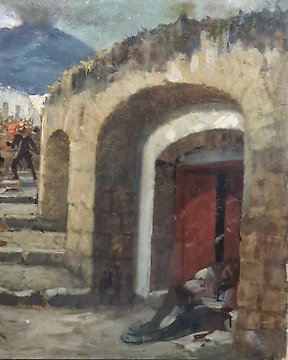
Michele Cammarano (1835-1920) - Battaglia alle falde del Vesuvio
编号 70479787

编号 70479787

Jan Massys (ca. 1510-ca. 1575) and workshop
The Lamentation of Christ Oil/ canvas (religned).
81.5 x 108.5 cm.
Old frame with attachment moulding in the shape of an altarpiece, expertly restored.
This depiction, with the characteristic main protagonists of a Lamentation of Christ - Mary, John, and Joseph of Arimathea - is a painterly, extremely high-quality repetition of the original painting by Quentin Massys, a known variant of which is in the Stedelijke Musea in Leuven (inv. no. S/37/M). The face of Joseph of Arimathea appears particularly successful, with almost individualising features, and characteristic of Jan Massys other known male type figures.
(78555/0001)
Excerpt from the research report written in 2012 by Professor Larry Silver (Ph.D. Harvard) - full expertise can be read in the provided images of the document:
“[…] Jan Massys achieved artistic independence upon hos father’s death in 1530 but surely had worked as an unregistered assistant in Quinten’s workshop, especially during the 1520s. […] While its figure types remain close to the models set by the later Quinten Massys of the 1520s, it need not date from the 1530s, though that would be a first hypothesis. […] A good close comparison for the presumed Joseph of Arimathea, is the figure of St. Joseph in Jan Massys’ early Holy Family with Elisabeth and John the Baptist (Pittsburgh, Carnegie-Mellon Museum). This same basic male figure type remains in Jan’s work, e.g. in one of the two Elders in his 1564 Susanna and the Elders (1567, Brussels, Musées Royaux). […] One presumes that Jan Massys continued the designs of his father in his own posthumous Massys workshop. […]
Another feature, […] is a large black letter “M”. Jan signed a number of his panels (IOANES MASSIIS) already in the 1530s and continued the practice throughout the 1560s, but Quinten seldom offered a signature or initial of any large size of prominence like this one. Infrared examination might turn up further original letters of the signature, but it now points much more clearly to the likelihood of Jan Massys than to Quinten.
[…] Outstanding execution of the corpse of Jesus and of the (very typical of Jan Massys) face of Joseph of Arimathea at right suggest the composition and hand of Jan Massys, but uneven execution of some more standard figures, such as the Virgin Mary, also give evidence of at least some workshop participation (though both the Virgin and St. John are clearly restored figures). The use of canvas suggests a later date and a second version of the basic Jan Massys composition, derived from Quinten’s Gaeta composition of the same half-length figures in reverse order.”
Larry Silver (Ph.D. Harvard, 1974), Farquhar Professor of Art History, emeritus, taught at Pennsylvania between 1997 and 2017 and still lives in the Philadelphia area. He specializes in painting and graphics of Northern Europe, particularly Germany and the Netherlands, during the era of Renaissance and Reformation, and he has a secondary expertise in Jewish art history. He served as President of the College Art Association as well as the Historians of Netherlandish Art, and previously taught at Berkeley and Northwestern. He also served as co-founder and Editor in Chief of "caa.reviews," the on-line reviews journal of the College Art Association, and he is a member of the Print Council of America.
Selected Publications
Art in History (1993); Jewish Art: A Modern History (2011; co-authored); Peasant Scenes and Land-scapes (Penn Press, 2006); monograph on Hieronymus Bosch (2006); monograph on Pieter Bruegel (2011); Marketing Maximilian (Princeton, 2008); Holy Roman Emperor Maximilian I (d. 1519); Rubens, Velázquez, and the King of Spain (2014; co-authored).
Co-edited volumes include The Essential Dürer (Penn Press, 2010) and Canons and Values (2019). Another research area, centered on Rembrandt, includes a book-length study, Rembrandt’s Faith (2009), co-authored with Shelley Perlove; Rembrandt and the Divine (2018) and an overview, Rembrandt's Holland (2018). In 2017 on the occasion of his retirement, a volume of collected essays appeared, The Primacy of the Image in Northern European Art, 1400-1700, edited by Debra Taylor Cashion, Henry Luttikhuizen, and Ashley West.
His museum exhibitions focused on professional engravers in the sixteenth-century Netherlands, Graven Images (1993) and oversized prints of that period, Grand Scale (2008).
#tableau23